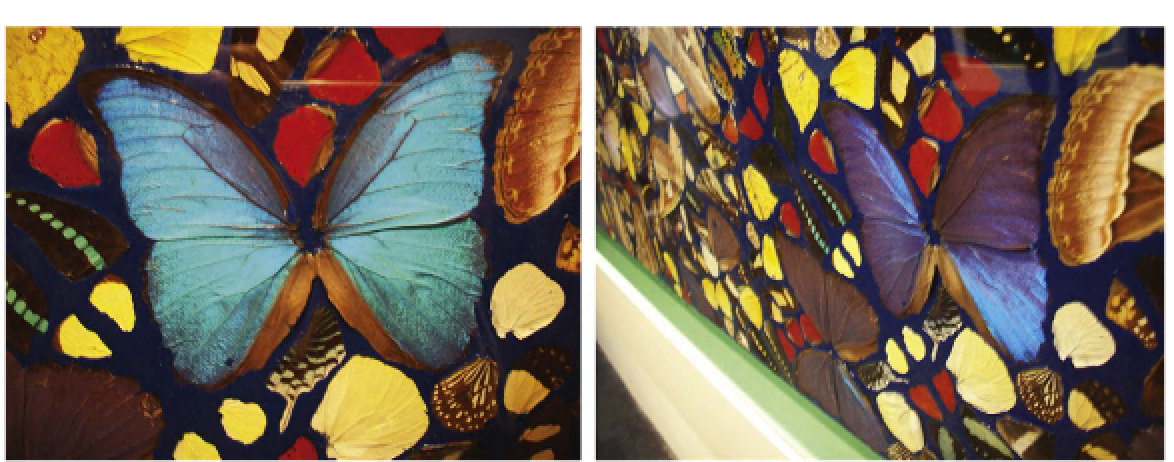Biomedical Engineering Reference
In-Depth Information
FIGURE 11.16
Two details from Damien Hirst's
Incorruptible Crown
, on display at the Museum of Contemporary Art,
Denver, CO, USA. The blue color of the wings of the butterflies at zero and small viewing angles are replaced by dull gray
at large viewing angles. (For interpretation of the references to color in this figure legend, the reader is referred to the web
version of this topic.)
That the
Morpho
blue color is of physical ori-
gin can be appreciated due to the fact that it is
replaced by dull gray at large viewing angles, as
is evident from
Figure 11.16
. The
Morpho
is bril-
liant sheen originates from the microscopic tex-
ture of the colorless transparent scales of about
100-
μ
m length that cover its upper wing sur-
faces
[3, 4]
. There are about 15 scales per mil-
limeter on the wing surface, and each scale has
a set of dozens of microscopic, evenly spaced,
parallel ridges. This textured structure resem-
bles a diffraction grating with a period
d
between
650 and 800 nm. A ridge typically has about 15
longitudinal branches (some
Morpho
species
have 6 to 10 branches on each side), all uni-
formly spaced and each one no thicker than a
fraction of a visible wavelength and with a den-
sity of 700-2,000 lamellae per mm. This is a tree-
like structure of lamellae that are self-assembled
from cuticles with a refractive index of 1.56.
Depending on the species, these structures effec-
tively reflect 150- to 300-nm-wide spectral bands
that peak at wavelengths ranging from 400 to
460 nm at 45-65% reflectance, thus producing
the beautiful iridescent
Morpho
blue colors
[50]
.
The physical mechanisms underlying struc-
tural color in the
Morpho
genus were extensively
studied by Kinoshita
et al
.
[11, 25-27]
. High
reflectance in the blue regime arises from multi-
layer interference. Diffuse reflectance is due to
the small widths and irregular heights of the
ridges. Blue pigment also enhances the struc-
tural color. Finally, transparent scales on top of
the wing act as optical diffusers and create gloss.
Thus a collaboration of four different mecha-
nisms, illustrated in
Figure 11.17
, provides the
brilliant
Morpho
blue.
11.4.4 Structural Colors Due
to Photonic Crystals
Structural colors exhibited by periodic multilay-
ered structures were discussed in Section
11.3.2
.
These structures are simple one-dimensional
photonic crystals. More complicated one-dimen-
sional photonic crystals found in certain
Cole-
optera
and
Scarabaeidae
beetles are structurally
chiral
[77]
, just like chiral liquid crystals
[78]
and
chiral sculptured thin films
[79]
. The helicoidal

